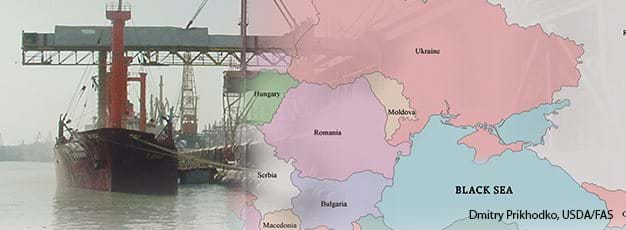Grain Exports from the Black Sea: How Large?

From 1996 to 2000, annual net grain exports from the former Soviet Union (mainly Russia, Ukraine, and Kazakstan) and other transition countries in the Black Sea region (Romania, Bulgaria, and Serbia) averaged only about 7 million metric tons. The exports were far short of forecasts made by Western analysts when these countries began their major economic reforms in the late 1980s and early 1990s. In 2001 and 2002, grain export levels from the Black Sea area shot to 25 million and 33 million tons, accounting for 12 and 15 percent of total world grain trade. Many thought the large exports signaled the arrival of the region as a formidable grain-export area. Optimism was dimmed, however, by a severe drop in grain production in 2003.
Early expectations of high exports from the region grew out of an assumption that the countries’ transition from centrally planned to market-based economies would trigger huge gains in productivity. During the Communist period, these countries had much lower agricultural productivity than Western countries, such as the United States, Canada, and Australia. Analysts expected that market-based reforms would reduce waste and raise productivity, substantially boosting grain output and exports. The countries bordering the Black Sea, however, have made less reform progress than Central European countries, such as Hungary, Poland, and the Czech Republic. In Russia, Ukraine, and Kazakstan, the virtually unreformed former state and collective farms inherited from the planned economy remain the main agricultural producers, along with small household plots tended by the farm workers. Agriculture in Romania, Bulgaria, and Serbia is largely in the hands of private farmers, but continues to be dominated by small, fragmented farms with low productivity.
Nature may have had more of a hand in the large 2001-02 grain exports by the Black Sea region than market forces. Very good weather for grains in those 2 years helped push average annual grain output in the region to 180 million tons, compared with 143 million tons during 1996-2000. Disappointing (though not terrible) weather then dropped grain production back to 127 million tons in 2003, below the average for 1996-2000. Even if the large growth in exports in 2000-02 was mainly the result of favorable weather conditions, the potential for market-induced growth in the coming decade is still strong. ERS model-generated forecasts show that if the Black Sea countries continue their current slow pace of reform, the region could become a medium-sized grain exporter of about 10 million tons a year by 2012-13. With more rapid reform and accelerated productivity growth, annual grain exports could be as high as 30-40 million tons, comprising 12-15 percent of world grain trade. Such export volumes would fulfill predictions that the region would become a major grain exporter.
Black Sea Grain Exports: Will They Be Moderate or Large?, by William M. Liefert, Olga Liefert, Ralph Seeley, and Edward Allen, USDA, Economic Research Service, October 2004

